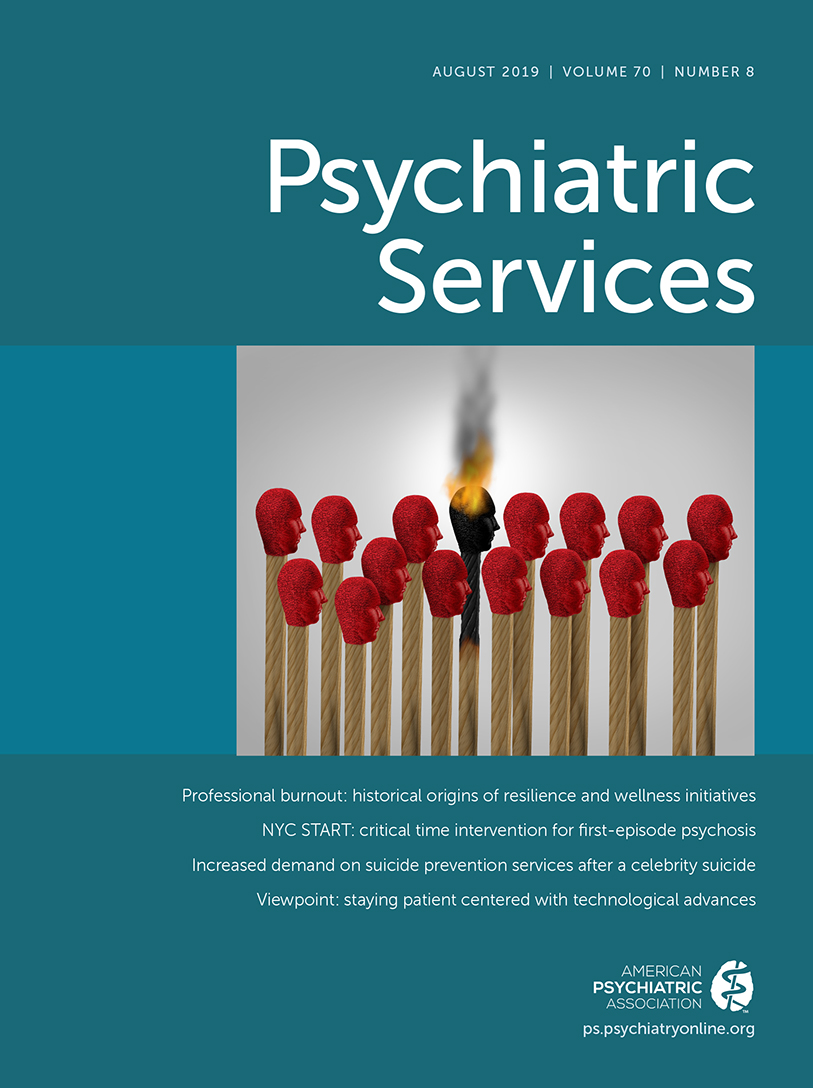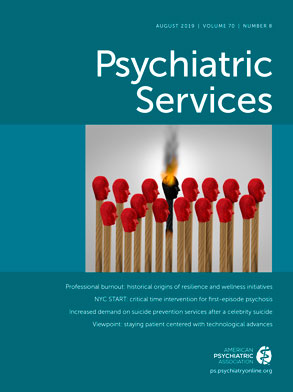Research has suggested that individuals with serious mental illnesses are not as physically healthy as the general population and are more likely to experience illnesses such as diabetes, obesity, and respiratory diseases (
1–
3). In a study of Medicaid claims of people with serious mental illnesses, 75% had a single chronic health condition, and 50% had two or more chronic health conditions (
4). Individuals with schizophrenia in particular have more risk factors for cardiovascular disease, including smoking, obesity, and lack of exercise (
5–
7).
Strikingly, individuals served by the public mental health system die an average of 25 years earlier than the general public (
8). Colton and Manderscheid (
9) found that public mental health clients had a higher relative risk of death compared with the general population, with the actual number of deaths in each state ranging from 1.2 to 4.9 times higher than the number expected. Similarly, findings from a recent meta-analysis indicated that the years of potential life lost among individuals with serious mental illnesses ranged from 1.4 to 32 years, with a median of 10 years (
10).
The impact of physical health on the lives of individuals with serious mental illnesses extends beyond increased mortality rates. There is also a concern that health concerns may limit community participation among individuals with serious mental illnesses, such as their ability to work, engage in leisure and social activities, and otherwise live in the community in a manner similar to everyone else. There is ample evidence suggesting that community participation is a medical necessity itself, having a positive impact on the physical, cognitive, and mental health of individuals with serious mental illnesses (
11,
12). Physical health issues are associated with limited energy and pain, which could reduce enthusiasm for participation and lead to diminished stamina. Moreover, attempts to address health concerns through medical appointments, pharmacy trips, and attention to health behaviors can be exhausting and further limit time and energy that could be devoted to meaningful participation in the community.
Research with individuals in the general population has illustrated the important role of physical health in facilitating community participation. Schultz and Edington (
13) found that both the presence of specific health conditions as well as more general health risk factors contributed to decreased job performance. Previous studies have also shown that subjective health affects participation in leisure activities (
14). Finally, individuals have discussed how challenging it can be to engage in activities and create a structure for the day because of chronic health problems and mobility issues (
15). Research on the relationship between the presence of physical health conditions and community participation among individuals with serious mental illnesses is scant. Examining the potential for such a relationship could advance researchers’ knowledge of factors affecting participation in this population and illuminate the full benefits of interventions targeting physical health.
Drawing from a larger study examining individual and environmental factors related to community participation among 300 adults with serious mental illnesses and 300 adults in the general population (
16–
18), this study examined associations between physical health indicators and community participation. It was hypothesized that physical health limitations and mobility impairments would be associated with reduced levels of participation among adults with serious mental illnesses, a pattern also seen among other adults in the general population. Given the prevalence of physical health issues in this population, such a relationship could be a potent additional explanation to the limited community participation of these individuals.
Discussion
This study is the first to examine associations between self-reported physical health and community participation among individuals with serious mental illnesses; it is also the first to compare such relationships with individuals without serious mental illnesses. In line with previous findings, participants with serious mental illnesses were more likely than participants without a diagnosed mental illness to report a physical health condition that limited their daily activities. Just as researchers have documented negative associations between physical health impairments and community participation for adults in the general population (
13,
14), we expected to find similar or even stronger associations among adults with serious mental illnesses. Interestingly, participants with serious mental illnesses who reported physical health impairments that interfered with life activities did not report significantly fewer community participation days or areas than participants with serious mental illnesses without such impairments. However, they did report lower sufficiency of participation, meaning that participation was done less often than they would like. In contrast, among participants without serious mental illnesses, those who had physical health limitations reported fewer participation days and areas but not lower sufficiency of participation.
A similar pattern of findings was seen when examining associations between community participation and mobility aids. Specifically, although there were no significant differences in participation days or areas between participants with serious mental illnesses who used a mobility aid and those who did not, participants with mobility aids reported lower sufficiency of participation. Among participants without serious mental illnesses, participants who used mobility aids reported fewer participation days and areas as well as lower sufficiency. Of note, there were no significant differences in reported use of mobility aids between the samples. This result is surprising given that participants with serious mental illnesses reported more back problems as well as more bone, joint, and muscle conditions. This finding may reflect disparity in access to needed mobility aids and should be a focus of future research and service delivery.
Finally, participants with serious mental illnesses had significantly lower scores than participants without serious mental illnesses on all four SF-12 domains. Similar to the results pertaining to physical conditions and mobility aids, there were few associations between SF-12 scores and community participation days and areas, but there were significant associations between each SF-12 domain and sufficiency of participation. Specifically, participants with lower SF-12 scores reported lower sufficiency of participation.
The consistent pattern of findings across self-reported physical health conditions, use of mobility aids, and physical health functioning suggests that although individuals with serious mental illnesses who report health limitations do not necessarily participate less frequently, or in fewer activity areas, they feel that they are not able to engage in activities as frequently as they would prefer. That is, they view their physical health as limiting their involvement, and if the conditions were not present, their community participation may likely increase. These findings are in line with research suggesting the distinction between objective functioning (in this case, number of participation days and areas reported) and subjective satisfaction with functioning (participants’ reports of whether they engage in activities as often as they prefer;
24).
Given that physical health appears to be more strongly associated with community participation among participants without serious mental illnesses, particularly when examining health status with the SF-12, it appears that other factors may be more important to consider when addressing barriers to participation among individuals with serious mental illnesses. These include individual-level factors such as psychiatric symptom distress (
25) and mental health functioning (
20) as well as aspects of the physical and social environment, including transportation, safety, and concerns about mental health stigma (
18). These factors should be the focus of future research aimed at addressing barriers to participation while also continuing to address physical health concerns that may limit active involvement.
This primarily descriptive study had several limitations. Sampling differences between participants with and without serious mental illnesses may reduce comparability of results. Participants without serious mental illnesses were drawn from a random national survey of the population that was geographically stratified, whereas participants with serious mental illnesses were not randomly selected. Generalizability concerns are also present. The participants without serious mental illnesses were older, more likely to be white, and more highly educated than members of the general population. The sample of individuals with serious mental illnesses only reflects the experiences of those receiving mental health services and may not generalize to individuals not using services. This study is correlational, and causal relationships should not be inferred. Longitudinal research examining associations between physical health and participation over time is needed to better understand the direction of effects. Furthermore, the magnitude of many of the correlations was small, and care should be taken when interpreting findings. Finally, given that data were self-reported, actual rates of physical health limitations and community participation may be higher or lower than those reflected in our study (
26). Similarly, we did not collect information about related health behaviors or conditions, such as smoking and obesity.
Despite these limitations, the findings of this study support emerging awareness of health disparities among individuals with serious mental illnesses (
27) and shed light on associations between physical health limitations and community participation. Programs to improve the health of individuals with serious mental illnesses have been successful (
28–
30), yielding both physical and psychological benefits, including improvements in quality of life, self-efficacy, and social inclusion (
31–
33). However, these programs usually seek to increase moderate-vigorous physical activity, which may not sufficiently replace time spent in sedentary activity. Thus it is important to examine the role of incidental activity, which involves physical activity associated with movement required for participation (
34). For example, a trip to a grocery store requires walking, reaching, and carrying items. Therefore, encouraging individuals to participate in the community provides opportunity for incidental activity and, as such, a reduction in sedentary time and physical inactivity. This focus aligns with interventions that help individuals with serious mental illnesses and chronic medical conditions manage health across multiple domains, including activity, diet, and sleep (
29,
35). Such programs are a necessary component of integrated behavioral health and primary care for this population (
36,
37).
Conclusions
This study found that adults with serious mental illnesses were more likely to report having a physical health condition that interfered with their life activities than adults without serious mental illnesses. For participants in both groups, physical health concerns and use of mobility aids were associated with lower reported rates of community participation. Interestingly, among participants with serious mental illnesses, those who reported physical health impairments did not report fewer participation days or areas than participants with serious mental illnesses without such impairments; however, they did report that participation was less frequent than they would like.
Further work is needed to better understand the complex relationship between physical health challenges and community participation, but results from our study suggest that it may limit individuals’ ability to participate as actively as they would prefer. Because of the reciprocal benefits that participation may have for physical health and social connectedness, it is imperative to address individual, environmental, and societal risk factors that result in higher rates of chronic illness and premature mortality among individuals with serious mental illnesses.

